
Dr. Haruko Kataoka (1927 - 2004)
Web Editor
Kenneth Wilburn
Hard Copy Illustrations
Juri Kataoka
Correspondents
Leah Brammer - Media
Rita Burns - Workshops
Mayumi Yunus - Translation
Cathy Williams Hargrave - Editions
Production and Distribution
Linda Nakagawa, Barbara Meixner, and the Sacramento Teachers Research Group
Send Articles to:
Suzuki Piano Basics Foundation
67 Shepard St., Rochester NY 14620
Fax: 585-244-3542
Email: hagberg-drake@juno.com
Memberships/Subscriptions
Linda Nakagawa
242 River Acres Drive
Sacramento, CA, USA 95831
Phone: 916-422-2952
Email:
g.nakagawa@comcast.net
Deadline for Next Issue: 15 March 2004

Dr. Haruko Kataoka (1927 - 2004)
Forgive me for not helping this time. I have not been feeling well. It is because I have become old and tired. The 10-Piano Concert in Sacramento was very difficult. I tried so hard to make it to the concerts. I had no time to rest. When I returned to Japan it was very hot, and I have not been well since the end of September.
I want to say that I worry when I see you all taking notes. [Editor's note: Dr. Kataoka discouraged note-taking and encouraged teachers instead to listen intently during lectures and lessons.] Teaching children-not just teaching them piano-is such a very special thing. It is totally different from teaching adults. We need to understand what is important-what requires the most care and attention. Dr. Suzuki was the first person to realize that childhood education is the most important education. The education received in childhood determines the child's future.
University education, of course, is different, and it is probably necessary for some things. Until now, conventional wisdom tells us that it is all right to have a mediocre teacher for small children, and that students should go to better teachers as they progress. Dr. Suzuki realized the error of this kind of thinking. The most important thing is childhood education. Teachers for young children must be the best teachers. In college, in a music conservatory, it is also a good thing to have a good teacher, but at this level we are talking about a completely different job--completely different work. Teachers for children are so much more important, and Dr. Suzuki was the first to realize this.
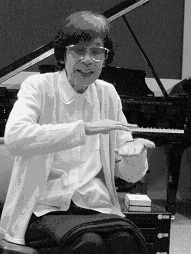
Dr. Haruko Kataoka, Matsumoto, Japan,
November 2003. Photo by Malinda Rawls
When teaching piano, the first most important consideration is that God gave children natural ability. For each and every student, you museach. When I was teaching Seizo Azuma as a young child, I kept telling myself not to break the nature of a child. I am still doing that. This is a basic of all human beingst not go against this or destroy it. When teaching technique, it is easy to make students a little tense. Please make sure-make a promise to God-to tell yourself not to break the nature of children when you teach.

Dr. Haruko Kataoka, Matsumoto, Japan,
November 2003. Photo by Malinda Rawls
It is all right if you do not learn many pieces quickly. Some people think that Suzuki method is for children who play difficult pieces. This is incorrect. The most important thing is not to break the student's nature. When I was teaching Seizo Azuma as a young child, I kept telling myself not to break the nature of a child. I am still doing that. This is a basic of all human beings. It is a rule of nature. The saddest thing is when you try so hard when you teach, and the result is that you are causing your students to be stiff and unnatural.
Dr. Suzuki liked to joke, saying it is easy to be a Suzuki teacher because all you have to do is say the same thing over and over. When I heard this about 30 years ago, I really thought it was a joke, but now I do not think so at all. I know he was very, very serious. What you say to a Book 1 student is the same thing you should be saying to an advanced student.
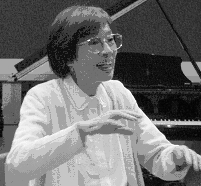
Dr. Haruko Kataoka, Matsumoto, Japan,
November 2003. Photo by Malinda Rawls
As you can see at the rehearsals, children do not have any strong desires; there is nothing they really want; they do not choose things for themselves. It is precisely because they do not make these choices that you must tell them, at every lesson, to make their hands soft or to move their thumbs sideways. In Sacramento I asked students to move the thumb sideways, but they could not do it because they had not been told by their teachers to do it at every lesson. I told them to play legato, not to crash or hit the piano, but they were not told enough by their teachers, so they could not do it.
It is the same for the children in Matsumoto, of course. They do not choose and they do not practice. It is the same thing all over the world. But children in Matsumoto are told by their teachers every time, and that is why, if you ask them, they can do it on the spot! So you might think you see teachers in Sacramento asking the same things as we tell them here in Matsumoto, but it is totally different, TOTALLY DIFFERENT!! The students here are told the same things all the time, and that is why they can fix something right away. I really want you to understand this difference.
I do feel that the teachers who brought students to Sacramento are saying the right things, but it is not 100%. Students are not being told how to play legato or how to be natural at every lesson. It is just not 100%. Playing legato is the most difficult thing on the piano. It is not the student's responsibility to do this well; it is the teacher's responsibility that they do it. Teachers who have come here are willing to work really hard. You are all hard-working teachers, so please have pride in your teaching children. Be proud of yourself.
I understand that you are trying really hard, but you need a great deal of patience when teaching children. The most important things are the basics. When you perform on the piano, you can play the melody and accompaniment at the same time. Sometimes it is different, but most of the time the melody is in the right hand and the accompaniment in the left hand. The most important part is the left hand. You are not teaching the left hand parts well. The left hand is in charge of the meter and the tempo. (At this point, Dr. Kataoka played the first 4 measures of Minuet 1 from the Bach Partita.) I told students to practice this and they did not, so I had them practice it here at rehearsals and then it became beautiful. All ten of them played the left hand with three beats. Today we will hear Cradle Song. This is another piece where nobody teaches the left hand. Teachers all forget the accompaniment and go straight to the melody. They tend to take care of the more beautiful things. The students here in Matsumoto are told the same things over and over, so if I tell them to do it tomorrow, they can do it. Children are excellent because the teachers are excellent. So you probably noticed that the children in Sacramento were probably told the same things at the rehearsals, but the difference is that the children here have been told the same things at every lesson.
Everything comes down to the basics. It is really quite simple. Everything is either two beats or three beats. Even compound time signatures are basically in two or three beats. Please teach this basic first, before anything else. Everyone does the opposite. (At this point, Dr. Kataoka sang the beginning of the Alla Turca, stressing the way everyone always does it, with the upbeat getting the strong sound and the actual first beat--the downbeat-- sounding light.) That is upside down! It is like building a house: you must first make the foundation.
It is wrong when people play on the tips of their fingers, and it is wrong when they dance with their arms when they play. God gave us the ability to use our fingers correctly. (Dr. Kataoka removed her shoes and demonstrated walking.) When you walk, your toes have to grasp the ground. People who walk incorrectly, putting weight on the side of their feet, develop problems. The hand operates in the same way. Problems arise in the hand whenever the fingers are used incorrectly. Please do research! Please research in groups, because it is difficult to do this work by yourself. Use a very soft hand. Use the pads of your fingers, not the fingertips. This sort of research has not been done by 80% of the pianists and violinists in the world. Dr. Suzuki did the research, and I learned from him how to research.

Dr. Haruko Kataoka, Matsumoto, Japan,
November 2003. Photo by Malinda Rawls
When I was younger, I played many difficult pieces, including concertos. People always praised me, but I always questioned it. I was so tired when I played, and I had to try so hard to play that I thought something must be wrong. People hand out praise irresponsibly. I listened to great pianists on LP's, people like Rudolph Serkin and Glenn Gould. I could hear them playing and singing at the same time. It sounded effortless. I thought at that time that there was something I was not doing right. I came to Matsumoto when I was 30 years old. I started then from the very beginning. You have all started your research, so now do it more.
I would like ten of you to come up and play Twinkle. (Eleven teachers played, one used the teacher's piano.) Make Twinkle C clear. Clear does not mean louder. Play Allegro. Keep the left hand the same throughout- it is not staccato. Play Alla Turca. (Only two or three teachers tried to play it.) Everyone should be playing! You are all teachers! Memorizing is not difficult. I used to think it was but when I started teaching the pieces so much I memorized them automatically. Try again, and this time I want everyone to at least try. Your backs are stiff because you do not know the piece. You MUST think you can do it!! At least try, so if you know a spot or two this will add up until you know the entire piece. It will not take long!
Our teacher left us suddenly, and much too soon. Those of us who had contact with her during the last several months of her life look back on our experiences at the 2003 summer workshops in June, at the Sacramento 10-Piano Concert in August and even at the Matsumoto 10-Piano Concert in November with disbelief knowing now that she was so ill and close to death, and yet remembering, or seeing on videotape, the force of her energy and enthusiasm in those last remaining days of her teaching. She is reported to have said, before she died, that she had no regrets. She taught isshokenmei, as hard as she could, until the very end.
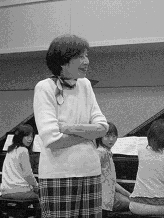
Dr. Haruko Kataoka, Matsumoto, Japan,
November 2003. Photo by Malinda Rawls
She left us with one very strong message, and that is to continue our research. This research she spoke of, the kind of research she learned from Dr. Suzuki (as she mentioned in her lecture to teachers printed on page one), is a unique kind of research, not understood in traditional circles. It involves expanding one's capacity for listening with concentration, for studying the mechanics of our own body as we use it to produce sound, for figuring out how students can be taught without destroying their wonderful nature. Before I went to Japan to study, I applied for a grant intended for "research" in Japan. My application was turned down. Not surprisingly, I had been unable to explain to the foundation in question the importance of this unique research, unlike any other research they knew about.
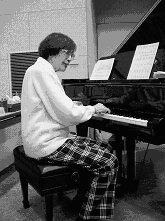
Dr. Haruko Kataoka, Matsumoto, Japan,
November 2003. Photo by Malinda Rawls
Kataoka Sensei researched many things during her career. Over this last period of fifteen years, I witnessed her research one question in particular. Her tenacity and persistence in finding an answer to this question was truly remarkable. The question involved the Chopin Polonaise in Ab major, Op.53, the most advanced piece programmed on this most recent 10-Piano Concert in Matsumoto.

Dr. Haruko Kataoka, Matsumoto, Japan,
November 2003. Photo by Andy Rawls
She often mentioned that it had always been physically difficult for her to execute the repetitive pattern of four descending octaves in the left hand in the middle of the piece. She felt as if she could barely make it through this passage. Her left hand was stiff and in pain by the end of it. As a young pianist, people always praised her ability to perform the piece, but she felt it was empty, irresponsible praise, since she knew that she did not really play the piece with ease. So she was left with the lingering question: how does a really good pianist execute this passage with relaxation and enough control to make musical sound.

Dr. Haruko Kataoka, Matsumoto, Japan,
November 2003. Photo by Andy Rawls
The answer to such a question is not easy. I recall sometime in the late 1980's that Sensei discovered a film of Artur Rubinstein performing the piece. Much of the performance was filmed with an overhead camera focused down on the keyboard. The first revelation came visually. It was easy to see Rubinstein's thumb moving sideways, taking every note. It moved very quickly as only fingers can. Sensei showed us this film at the time and pointed out the moving thumb.
Her research did not end with observing Rubinstein. She began reading scientific studies about the human hand and how it works. There were many lectures in which she would discuss, in great detail, the difference between human hands and those of apes, remarking on the miraculous nature of our hands and what they can accomplish. The greatest difference between human and ape hands is, of course, the structure of the thumb. Some scientists believe actually that this structural difference in the hand, and not the brain, is the source of human intelligence itself.
As she conducted all this research, Sensei began teaching all of us, teachers as well as students, to move our thumbs as we played. It seemed that, for months on end, that this is all she was teaching. She was determined to give this important ability to each and every one of us-to preserve the ability in children and to regain the ability in us teachers who had misused our hands for years and years.
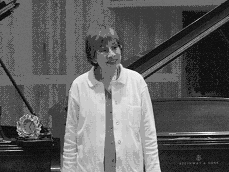
Dr. Haruko Kataoka, Matsumoto, Japan,
November 2003. Photo by Andy Rawls
Kataoka Sensei carried on the research of the moving thumb all this time, until the point where she was finally able to teach ten students to perform the Polonaise with the natural ease and true ability that she felt she never had at their age. She had finally researched enough and taught that piece enough to program it on the 10-Piano Concert. It took 15 years, but she never gave up researching the natural use of the thumb, and re-realizing that this was the key element in being able to play something she previously could not play.
How intelligent and how persistent she was! Can we continue after her and pursue this same research? Are there teachers among us who can execute the passage in question with natural technique? Can we teach students to do it? Do we really understand how to use our thumbs?
Kataoka Sensei was a truly great person. She leaves such a challenge both to those of us who knew her and to people who will come in contact with her teaching even after her death. This challenge is the gift she gave to all of us. May we treasure it, become worthy of it, and remain eternally grateful.

Dr. Haruko Kataoka, Matsumoto, Japan,
November 2003. Photo by Malinda Rawls

Dr. Haruko Kataoka, Matsumoto, Japan, November 2003. Photo by Leah Brammer
|
KAREN HAGBERG'S SPEECH AT KATAOKA SENSEI'S FUNERAL My name is Karen Hagberg, and I am the President of the Suzuki Piano Basics Foundation. This is a worldwide organization to follow the teachings of Kataoka Sensei. After this very sad week, our purpose will be to continue Sensei's teaching to the best of our ability. Musicians trained in Europe or America are often asked why we would come to Japan to learn about our own music. I am sure I speak for the seven other teachers who traveled from abroad to be here today. We feel so lucky that we could understand what was lacking in our traditional education. We feel lucky thano teaching. She taught us how to teach all our students, and not just the talented few. t we met Kataoka Sensei and that she could teach us things we had not learned-the most important things that go to the heart and soul of music. We also feel lucky that Kataoka Sensei was such a serious and dedicated student herself, and could bring Suzuki Sensei's work into the world of pia Some of the foreign teachers here today have studied with Kataoka Sensei for nearly thirty years. We have taught hundreds of students during this long time. There are many teachers who were unable to be here today who have also studied a long time and have taught many students as well. By now, the students are growing up, and some are becoming teachers themselves. Sensei's teaching has, by now, touched thousands of people all over the world. Kataoka Sensei was our energy and our conscience. Somehow, she made us better than ourselves. I know I am not the only teacher who wonders how we can get along without her. We can never forget her. We extend our deep condolences to Sensei's family, to the teachers she worked with, and to her students and their families. We share your feelings of grief and profound loss. Sensei, please rest in peace.
|
Over 400 people were in attendance. Many of the mourners were current and former students and their families and teachers of Suzuki Piano Basics. Among these teachers were seven from the United States (Bruce Anderson, Florida; Elizabeth Armour, Tennessee; Leah Brammer, Georgia; Karen Hagberg, New York; Fumi Kawasaki, California; Linda Nakagawa, California; and Vicki Seil, Arizona) and one from Holland (Huub de Leeuw). Two other Americans, Masako Nishiyama, a parent from Sacramento, California, and Celine Browning, former resident of Japan and a longtime student of Kataoka Sensei, also attended.
The funeral hall was filled with floral arrangements from individuals and Suzuki organizations from all over the world whose names were written on plaques hung at the sides of the room. A large photograph of Sensei and the urn on the funeral altar were surrounded by massive banks of pink and white flowers. On the floor in front of the altar were chairs for seven priests and monks who chanted and played drums, gongs, cymbals and bells.
The service began with a short speech by the concert pianist, Seizo Azuma, who was a student of Kataoka Sensei from the age of five. After he spoke, Mr. Azuma performed three pieces: the first by the 20th century Spanish composer, Frederico Mompou, and the other two by Chopin (the famous Funeral March and the third movement of the Third Piano Sonata). Following this solemn and highly moving performance, the monks and priests chanted and played the instruments for quite a long time. Sensei's name could be heard periodically inserted into their ancient Buddhist text.
Following the chanting, several people gave speeches. The Mayor of Matsumoto, the Director of the Talent Education Institute, a longtime personal friend, a medical student who studied piano with Sensei since early childhood, her 11-year-old granddaughter, and Karen Hagberg all spoke. At the end, Keiko Nozawa, one of the Matsumoto teachers who has worked most closely with Sensei, read around 10-15 messages that had been received from individuals and organizations worldwide.
After the speeches, all in attendance were invited to offer incense and prayers at several stations at the front of the room. When this offering was completed, Sensei's son, Yumihito Kataoka, expressed the gratitude of the entire family for everybody's presence and invited us all to a dinner/reception downstairs. The family ceremoniously carried the photograph, urn, and food offering to the reception hall, where a shrine was set up. Sensei's presence was deeply felt by us all.
During the reception, members of the family spoke individually to all attendees, expressing their thanks. We were given memorial gifts, and many of us left with bunches of flowers and boxes of sweets from the altar.
According to Buddhist custom, Sensei's ashes will remain at her son's residence in Matsumoto for 49 days, after which they will be interred in Tokyo at the site of her father's grave.
Reported by Karen Hagberg
Although the specific use for this fund is yet to be determined, it will be used for projects that will preserve Dr. Kataoka's memory and her method of teaching.
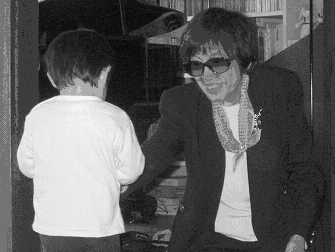
Dr. Haruko Kataoka, Matsumoto,
Japan, November 2003. Photo by Malinda Rawls
If you are renewing your membership at this time, a memorial donation may be included with your renewal. Please specify "memorial donation" on your renewal form. Otherwise, separate donations may be mailed to our treasurer, Linda Nakagawa, 242 River Acres Drive, Sacramento CA 95831.
Thank you so much for your support.
Suzuki Piano Basics Foundation wishes to acknowledge, with gratitude, the numerous messages of condolence we have received from all over the world: Europe, Australia, Canada, and around the United States. It has been a tremendous outpouring of love and emotion, an expression of how deeply this loss is felt, and by how many people. We will post these messages on our website, and welcome additional ones.
First Online Edition: 15 March 2004
Last Revised: 21 May 2024